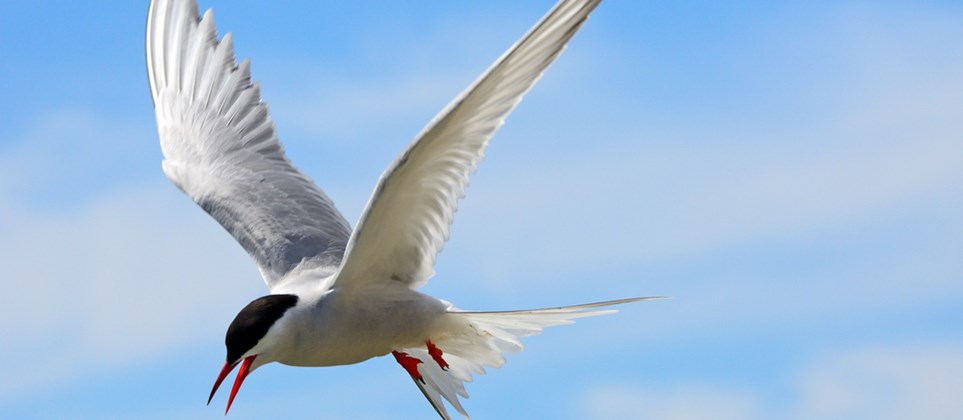
Keflavik Airport is Iceland's largest airport. Its area does not include any protected areas or designated archaeological remains. However, the Miðnesheiði moor, where the airport is situated, is among the world’s largest nesting grounds for the lesser black-backed gull. The airport area also supports a wealth of moorland birds. Attempts have been made to modify vegetation within the area, including by planting lupins, applying organic fertilisers and sowing.
Airport habitats vary in the diversity of their flora and fauna. We at Isavia actively monitor and record wildlife activity in our airport areas. The level of detail of the records varies between airports, as does the level of wildlife presence, which consists mostly of birds, although occasionally reindeer, foxes or rabbits need to be dispersed from areas where they pose a risk.
An important part of airfield operations is minimising hazards for air passengers, including the risk of animal-aircraft collisions such as bird strikes. This is achieved through wildlife hazard management, which includes scaring, exclusion from the airport area, habitat management and other strategies. A record is kept of our wildlife control actions and general developments of the fauna at each airport. Scaring obviously affects wildlife but is necessary to ensure the safety of aircraft and passengers and therefore an integral part of our wildlife management.
Foxes are the only wild land animals living at and around Keflavik Airport. Their number has dwindled significantly in recent years and fox sightings are rare, although more prevalent in 2016 than in many previous years. While the vast majority of birds in the area are migratory, a small contingent of ptarmigan maintains a year-round presence.
The table below lists the species of wildlife, all of them birds, recorded in our airport areas. It only includes species dispersed by our staff from airport areas, so is far from exhaustive for all species inhabiting them. The species are classified by their status on the IUCN Red List of Threatened Species. Their legal status in Iceland is also indicated. Species’ relative abundance in Iceland can differ from global figures, so the list includes species not under threat according the IUCN list but protected under Icelandic law.
Species | Scientific name | IUCN status | Legal status in Iceland |
European rabbit | Oryctolagus cuniculus | Not applicable (NA) | Not protected |
Cat | Felis silvestris catus | Not applicable (NA) | Not protected |
American mink | Mustela vision | Not applicable (NA) | Not protected |
Whooper swan | Cygnus cygnus | Least concern (LC) | Protected |
Greylag goose | Anser anser | Least concern (LC) | Protected except from 20 Aug to 15 Mar |
Pink-footed goose | Anser brachyrhynchus | Least concern (LC) | Protected except from 20 Aug to 15 Mar |
European golden plover | Pluvialis apricaria | Least concern (LC) | Protected |
Black-headed gull | Larus ridibundus | Least concern (LC) | Protected except from 1 Sep to 15 Mar |
Common snipe | Gallinago gallinago | Least concern (LC) | Protected |
Brant | Branta bernicla | Least concern (LC) | Protected |
Arctic fox | Vulpes lagopus | Least concern (LC) | Protected |
Common ringed plover | Charadrius hiaticula | Least concern (LC) | Protected |
Redwing | Turdus iliacus | Least concern (LC) | Protected |
Eurasian whimbrel | Numenius phaeopus | Least concern (LC) | Protected |
Common starling | Sturnus vulgaris | Least concern (LC) | Protected |
Wood mouse | Apodemus sylvaticus | Least concern (LC) | Protected |
Black-tailed godwit | Limosa limosa | Least concern (LC) | Protected |
Dunlin | Calidris alpina | Least concern (LC) | Protected |
White wagtail | Motacilla alba | Least concern (LC) | Protected |
Merlin | Falco columbarius | Least concern (LC) | Protected |
Northern wheatear | Oenanthe oenanthe | Least concern (LC) | Protected |
Mallard | Anas platyrhynchos | Least concern (LC) | Protected except from 1 Sep to 15 Mar |
Meadow pipit | Anthus pratensis | Least concern (LC) | Protected |
Lesser black-backed gull | Larus fuscus | Data deficient (DD) | Not protected |
Northern fulmar | Fulmarus glacialis | Endangered (EN) | Protected except from 1 Sep to 15 Mar |
Glaucous gull | Larus hyperboreus | Endangered (EN) | Protected except from 1 Sep to 15 Mar |
Parasitic jaeger | Stercorarius parasiticus | Endangered (EN) | Protected except around protected eider-duck nesting sites in the period April 15 - July 14 |
Purple sandpiper | Calidris maritima | Endangered (EN) | Protected |
Great black-backed gull | Larus marinus | Endangered (EN) | Not protected |
Common raven | Corvus corax | Vulnerable (VU) | Not protected |
Arctic tern | Sterna paradisaea | Vulnerable (VU) | Protected |
Black-legged kittiwake | Rissa tridactyla | Vulnerable (VU) | Protected except from 1 Sep to 15 Mar |
Snow bunting | Plectrophenax nivalis | Vulnerable (VU) | Protected |
Northern gannet | Morus bassanus | Vulnerable (VU) | Protected |
Eurasian oystercatcher | Haematopus ostralegus | Vulnerable (VU) | Protected |
Common eider | Somateria mollissima | Vulnerable (VU) | Protected |
Short-eared owl | Asio flammeus | Near threatened (NT) | Protected |
Rock ptarmigan | Lagopus muta | Near threatened (NT) | Protected except for a few days in autumn according to regulations |
European herring gull | Larus argentatus | Near threatened (NT) | Not protected |
Common redshank | Tringa totanus | Near threatened (NT) | Protected |
